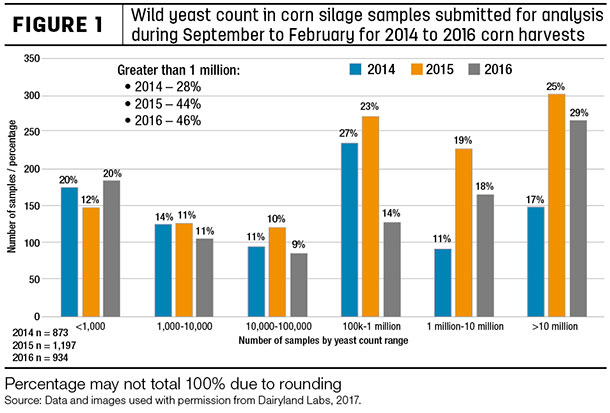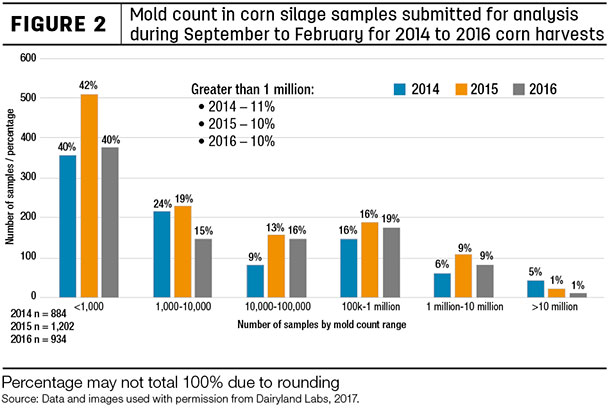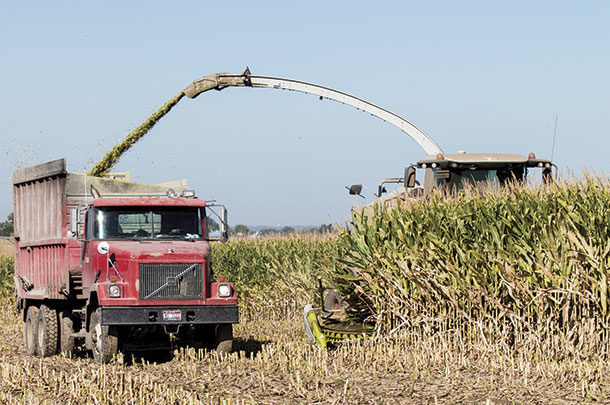Agronomists want to know how various hybrids performed after ensiling, and veterinarians are concerned about pathogens and other disease-causing organisms. One final series of tests the dairy producer should scrutinize is the mold, wild yeast and mycotoxin levels. Knowing these counts may impact how silage is fed and can act as a guidepost for the next year.
Since the 2016 harvest concluded, one forage testing lab in Wisconsin has tested 934 corn silage samples for mold and wild yeast. When we compare data from 2014, 2015 and 2016 corn silage samples, we observe some important trends related to mold and wild yeast levels.
It is important to note these samples are from all over the U.S., but they primarily arrived from the Upper Midwest. Also, because these data are composite data, sampling technique, sample handling and shipping speed are not taken into account.
We recognize drawing conclusions from one sample or even evaluating one year in isolation can lead to false assumptions. However, these data represent mold and wild yeast counts from three years and are generally from the same geographic region in each of the three years.
Wild yeast is an increasing concern
The corn silage samples received over the past two years have much higher levels of wild yeast than prior years. In 2014, producers submitted 873 corn silage samples for wild yeast analysis (Figure 1).

Of those samples, 17 percent had more than 10 million colony-forming units per gram (cfu per gram), and 11 percent had more than 1 million cfu per gram. Combined, 28 percent of corn silage samples had over 1 million cfu per gram after the 2014 harvest. Over the past two years, results show a rise in wild yeast count.
For corn silage harvested in 2015, samples arriving at the lab had over 1 million cfu per gram 44 percent of the time. In 2016, 46 percent of the samples contained over 1 million cfu per gram. Note that 29 percent of the 2016 corn silage samples had over 10 million cfu per gram.
The figures can be a bit deceptive if you’re only looking at the height of the bars. The bar height is simply a count of samples in each range, but the percentages are based on total submissions. Because producers submitted 263 more samples in 2015 versus 2016, the total number of samples in each range is greater. The percentages listed over each bar are more telling than the height when comparing year-to-year.
Mold counts remain stable
Corn silage samples were also evaluated for mold count. In 2014, producers submitted 884 corn silage samples for mold analysis (Figure 2).

Of those samples, 5 percent had more than 10 million cfu per gram, and 6 percent had more than 1 million cfu per gram. Combined, 11 percent of corn silage samples had over 1 million cfu per gram after the 2014 harvest. Over the past two years, results have been stable for mold count.
This percentage was virtually unchanged in 2015 and 2016, with 10 percent of samples arriving at the lab having over 1 million cfu per gram.
Why the increase in wild yeast count?
There is actually very little scientific data about why wild yeast spores are more prevalent in certain years versus others on the surface of corn plants. What is known, though, is the Upper Midwest had more rain during August and September 2015 and 2016 than in 2014. The National Oceanic and Atmospheric Administration has an excellent website for reviewing regional precipitation of prior years.
These data show approximately 8 inches of rainfall during August and September 2014 in Madison, Wisconsin. In 2015 and 2016, the National Oceanic and Atmospheric Administration recorded approximately 10 inches of rainfall in Madison, Wisconsin.
Wild yeast spores are found in standing corn at low levels – approximately 310,000 cfu per gram. During silage fermentation, once air is exhausted and silage conditions become anaerobic (free of oxygen), many yeast species can actively ferment sugars and produce ethanol and carbon dioxide.
Once we reintroduce air into the silage by removing oxygen-barrier covers and feeding the silage, yeast cease fermentation in favor of respiration.
Once yeast begin respiration, they rapidly multiply, consume sugars and produce heat, water and carbon dioxide. In summer months, when temperatures rise, wild yeast strains multiplying in silage raise the silage temperature. Certain strains of wild yeast can also impact milk components as they shift rumen bacterial and fungal populations.
What can we do in 2017?
We have no assurance of weather patterns and growing conditions in 2017; this much we know. However, there are basic silage management steps we need to continually remember that will help reduce the wild yeast and mold levels in our corn silage and rations.
First, modify harvest height by cutting corn silage a few inches higher than normal and leaving some of the lower-level structures in the field. This is a practice often employed to reduce nitrate concentration in silage, especially after rain.
After rain events, the lower portions of the plant are splashed with soil-born organisms like mold, and wild yeast and excessive dirt in silage have no nutritional value. Increasing ash content of forages by 2 percent can result in reduced milk per ton of 3 to 5 percent. By raising the chopper head height, less microbial contamination is introduced.
Second, practice all the good silage management principles we know but often skip during the rapid pace of harvest.
1. Harvest at the optimum maturity and moisture.
2. Utilize a quality, well-researched additive. Consider using an inoculant containing Lactobacillus buchneri for increased aerobic stability during storage and feedout.
3. Harvest additional forage for transition feeding.
4. Pack to the correct weight to exceed density requirements of greater than 17 pounds per cubic foot on a dry matter basis.
5. Seal with two layers of oxygen-impervious plastic and plenty of weight to secure the covering.
6. Remove any spoilage to protect integrity of the ration.
7. Feed off silage with the correct method at a rate of 12 inches per day.
Third, and finally, feed more often during summer months. If your forage tests show high levels of mold and wild yeast, feeding more frequently can reduce the amount of time these organisms grow and multiply. Forage additives can also help reduce mold and wild yeast growth.
The 2015 and 2016 corn crops presented, and continue to present, challenges for dairy producers and nutritionists. We need to continue to follow good silage management principles and employ a few minor changes in our feeding practices for the rest of this year to manage silage with high levels of wild yeast. Then we get to do it all over again this fall.
Following the practices outlined here, and weather willing, our 2017 corn silage will be the best crop we have ever harvested. ![]()
PHOTO: Wild yeast levels have continued to rise in the past two years. Silage best management practices can reduce the impact. Photo by Lynn Jaynes
References omitted but are available upon request. Click here to email an editor.

-
Eugene Rodberg
- Product Manager of Animal Nutrition and Health
- Kemin
- Email Eugene Rodberg










